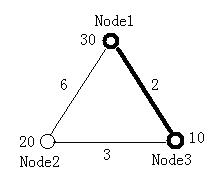hdu 2489(状态压缩+最小生成树)
Minimal Ratio Tree
Time Limit: 2000/1000 MS (Java/Others) Memory Limit: 32768/32768 K (Java/Others)
Total Submission(s): 3899 Accepted Submission(s): 1196
Given
a complete graph of n nodes with all nodes and edges weighted, your
task is to find a tree, which is a sub-graph of the original graph, with
m nodes and whose ratio is the smallest among all the trees of m nodes
in the graph.
contains multiple test cases. The first line of each test case contains
two integers n (2<=n<=15) and m (2<=m<=n), which stands for
the number of nodes in the graph and the number of nodes in the minimal
ratio tree. Two zeros end the input. The next line contains n numbers
which stand for the weight of each node. The following n lines contain a
diagonally symmetrical n×n connectivity matrix with each element shows
the weight of the edge connecting one node with another. Of course, the
diagonal will be all 0, since there is no edge connecting a node with
itself.
All the weights of both nodes and edges (except
for the ones on the diagonal of the matrix) are integers and in the
range of [1, 100].
The figure below illustrates the first test case in sample input. Node 1 and Node 3 form the minimal ratio tree.
each test case output one line contains a sequence of the m nodes which
constructs the minimal ratio tree. Nodes should be arranged in
ascending order. If there are several such sequences, pick the one which
has the smallest node number; if there's a tie, look at the second
smallest node number, etc. Please note that the nodes are numbered from 1
.
30 20 10
0 6 2
6 0 3
2 3 0
2 2
1 1
0 2
2 0
0 0
1 2
#include <stdio.h>
#include <iostream>
#include <string.h>
#include <algorithm>
#include <math.h>
using namespace std;
const int N = ;
const int INF = ;
int graph[N][N];
int weight[N];
int state[<<N];
int a[N],result[N];;
int n,m;
int vis[N],low[N];
void input(){
for(int i=;i<=n;i++) scanf("%d",&weight[i]);
for(int i=;i<=n;i++){
for(int j=;j<=n;j++){
scanf("%d",&graph[i][j]);
}
}
}
bool check(int num){
int cnt =;
while(num){
if(num&) cnt++;
num = num>>;
}
if(cnt==m) return true;
return false;
}
void init(int &k){
for(int i=;i<(<<n);i++){
if(check(i)) state[k++]=i;
}
k--;
}
int prim(int n,int pos){
memset(vis,,sizeof(vis));
for(int i=;i<n;i++){
low[a[i]] = graph[pos][a[i]];
}
vis[pos] = true;
int cost = ;
for(int i=;i<n;i++){
int Min = INF;
for(int j=;j<n;j++){
if(!vis[a[j]]&&low[a[j]]<Min){
pos = a[j];
Min = low[a[j]];
}
}
vis[pos] = true;
cost +=Min;
for(int j=;j<n;j++){
if(!vis[a[j]]&&low[a[j]]>graph[pos][a[j]]) low[a[j]] = graph[pos][a[j]];
}
}
return cost;
}
int main()
{
while(scanf("%d%d",&n,&m)!=EOF,n+m){
int k=;
init(k);
int min_id=N;
double _ratio = INF*1.0;
input(); for(int i=;i<=k;i++){
int num = state[i];
int t =,V=;
for(int j=;j<n;j++){
if((num>>j)&){ ///这里代表第j+1个点要选进去
a[t++] = j+;
V += weight[j+];
}
}
int cost = prim(t,a[]);
double temp1 = cost*1.0/V;
if(temp1<_ratio){
_ratio = temp1;
for(int i=;i<t;i++) result[i] = a[i];
}
}
for(int i=;i<m-;i++){
printf("%d ",result[i]);
}
printf("%d\n",result[m-]);
}
}
hdu 2489(状态压缩+最小生成树)的更多相关文章
- HDU 1074 (状态压缩DP)
题目链接: http://acm.hdu.edu.cn/showproblem.php?pid=1074 题目大意:有N个作业(N<=15),每个作业需耗时,有一个截止期限.超期多少天就要扣多少 ...
- hdu 4739(状态压缩)
题目链接:http://acm.hdu.edu.cn/showproblem.php?pid=4739 思路:状态压缩. #include<iostream> #include<cs ...
- HDU 3341 状态压缩DP+AC自动机
题目大意: 调整基因的顺序,希望使得最后得到的基因包含有最多的匹配串基因,使得所能达到的智商最高 这里很明显要用状态压缩当前AC自动机上点使用了基因的情况所能达到的最优状态 我最开始对于状态的保存是, ...
- hdu 2167(状态压缩基础题)
题意:给你一个矩阵,让你在矩阵中找一些元素使它们加起来和最大,但是当你使用某一个元素时,那么这个元素周围的其它八个元素都不能取! 分析:这是一道比较基础的状态压缩题,也是我做的第三道状态压缩的题,但是 ...
- hdu 1565(状态压缩基础题)
题意:容易理解. 分析:这是我做的状态压缩第二题,一开始超内存了,因为数组开大了,后来超时了,因为能够成立的状态就那么多,所以你应该先把它抽出来!!总的来说还是比较简单的!! 代码实现: #inclu ...
- HDU 2553 状态压缩
N皇后问题 Time Limit: 2000/1000 MS (Java/Others) Memory Limit: 32768/32768 K (Java/Others)Total Submi ...
- hdu 3006(状态压缩)
The Number of set Time Limit: 2000/1000 MS (Java/Others) Memory Limit: 32768/32768 K (Java/Others ...
- hdu 4033 状态压缩枚举
/* 看别人的的思路 搜索搜不出来我太挫了 状态压缩枚举+好的位置 */ #include<stdio.h> #include<string.h> #define N 20 i ...
- hdu 2489(枚举 + 最小生成树)
题目链接:http://acm.hdu.edu.cn/showproblem.php?pid=2489 思路:由于N, M的范围比较少,直接枚举所有的可能情况,然后求MST判断即可. #include ...
随机推荐
- Altium Designer之模块复用——设备图表符与Snippets
Altium Designer中的设备图表符(Device Sheet Symbol)和Snippets是设计中模块复用的利器,下面简单介绍下这个两个功能的使用. 一.设备图表符(Device She ...
- 安测云验证有CTA问题
背景: 现在所有的app 都需要通过工信部的审核.用户不同意之前,不能联网. 那么,我怎么知道自己的应用有没有联网呢?那么多sdk ,那么多代码?我怎么测试呢? 哈哈,我们测试给的方法真的很管用. l ...
- springboot遇见问题总结
今天开始学习创建springboot项目 问题1: 产生异常: 创建项目目录: demo代码: 代码Controller import org.springframework.web.bind.ann ...
- javascript类式继承模式#4——共享原型
<!DOCTYPE html PUBLIC "-//W3C//DTD XHTML 1.0 Transitional//EN" "http://www.w3.org/ ...
- Vbs 测试程序一
转载请注明出处 有点小恶意哦!慎重测试 'This procedure is written in SeChaos, only for entertainment, not malicious com ...
- 【UVA10655】 Contemplation! Algebra
题目 给定 \(p = a + b\) 和 \(q = ab\) 和 \(n\),求 \(a ^ n + b ^ n\). $0\le n\lt 2^{63} $ 分析 大水题. 先考虑 \(n\) ...
- java中封装的概念
封装(Encapsulation)是类的三大特性之一, 就是将类的状态信息隐藏在类的内部,不允许外部程序直接访问, 而是通过该类提供的方法来实现对隐藏信息的操作和访问. 简而言之,就是隐藏内部实现,提 ...
- jQuery easyuI datagrid 多行编辑
在easyUI 动态绑定部分数据后,需要有部分列可以修改,研究了一天终于搞定.这是小弟的做法,望各位有好招的大侠指点. 1.添加jQuery 和jQuery easyuI的引用. 2.添加id为tt的 ...
- React02
目录 React 进阶提升 条件渲染 受控组件* 状态提升* 组件数据流 TODO-LIST 设置服务器端口 列表渲染 条目PropTypes检查类型 export & import Refs ...
- MySQL事物相关学习
总结下最近对MySQL数据库的认识 Q:在手动开启事物后,commit失败是否需要显示的rollback? A:在网上查了不少资料,没有查到明确的答案.问了身边的朋友,朋友也不太了解,不过均表示显示的 ...


